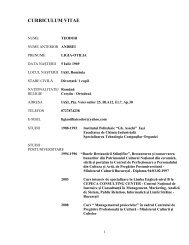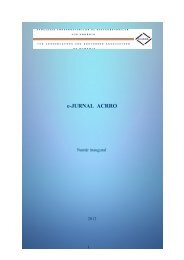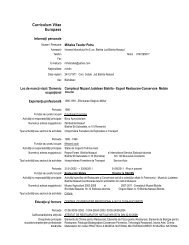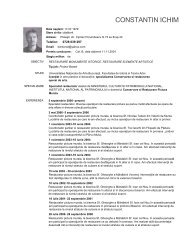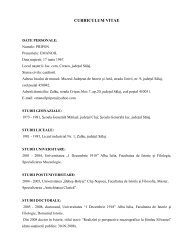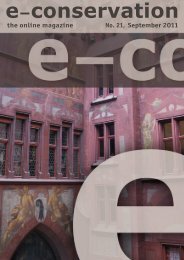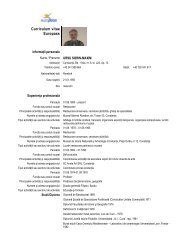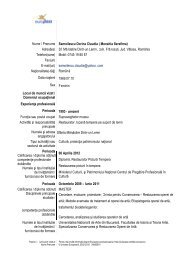e-conservation the online Magazine 16, oct 2010.pdf
e-conservation the online Magazine 16, oct 2010.pdf
e-conservation the online Magazine 16, oct 2010.pdf
Create successful ePaper yourself
Turn your PDF publications into a flip-book with our unique Google optimized e-Paper software.
REVIEWS<br />
The afternoon session focused on four different<br />
<strong>the</strong>mes: smalt pigment quantitative EDX analysis;<br />
medieval window flashed glass composition, structure<br />
and manufacturing processes; organic remains<br />
preserved by metal corrosion products;<br />
and a multi-analytical study of <strong>the</strong> pigments in<br />
17 th century Portuguese tiles (“azulejos”). The<br />
first presentation, by Marika Spring, introduced<br />
several examples of SEM-EDX analysis on smalt<br />
samples from a number of paintings in <strong>the</strong> National<br />
Gallery ranging in date and geographical<br />
origin. The variations in arsenic content as well<br />
as possible effects of arsenic on <strong>the</strong> properties<br />
of <strong>the</strong> glass were discussed. The effect of various<br />
factors such as pressure, beam gas and working<br />
distance on <strong>the</strong> degree of beam skirting and on<br />
quantitative analysis were also focused.<br />
The poster session continued during <strong>the</strong> tea break.<br />
In <strong>the</strong> last session of <strong>the</strong> day <strong>the</strong> speakers brought<br />
into discussion very distinct topics, such as <strong>the</strong><br />
investigation of medieval opaque glasses and<br />
enamels, analyses of chrome-yellow and chromeorange<br />
dyestuffs used for domestic and imported<br />
cotton fabrics “Touzan” (a vertically stripped Japanese<br />
fabric) in <strong>the</strong> 19 th century, and <strong>the</strong> study<br />
of inscriptions, filing and polishing marks on <strong>the</strong><br />
bronze weapons from <strong>the</strong> Qin Terracotta Army in<br />
China.<br />
The first day ended with a reception at <strong>the</strong> Addis<br />
Gallery, in <strong>the</strong> British Museum.<br />
The second day started with a presentation by<br />
Shirley Northover, focused on <strong>the</strong> application of<br />
electron backscattered diffraction (EBSD) in archaeology.<br />
EBSD patterns are characteristic of <strong>the</strong> structure<br />
and local crystallography orientation of <strong>the</strong><br />
material under <strong>the</strong> beam. By systematically collecting<br />
and analysing <strong>the</strong>se patterns, maps can<br />
be built up revealing <strong>the</strong> distribution of present<br />
phases, showing grain sizes and shapes, and giving<br />
“Quantitative EDX analysis of smalt pigment in <strong>the</strong> variable<br />
pressure SEM”, by Marika Spring.<br />
information on <strong>the</strong> deformation levels of <strong>the</strong> surface.<br />
Hector Lozano spoke on <strong>the</strong> re-discovery of<br />
Mexican fea<strong>the</strong>red textile, a very peculiar technique,<br />
of which only six known textiles still exist,<br />
all of <strong>the</strong>m from <strong>the</strong> 17 th and 18 th centuries. In<br />
this case SEM was used to identify <strong>the</strong> materials<br />
present in <strong>the</strong> fea<strong>the</strong>red yarns particularly <strong>the</strong><br />
identification of <strong>the</strong> birds from which <strong>the</strong> fea<strong>the</strong>rs<br />
were obtained. The next communication was<br />
on <strong>the</strong> study of raw materials used in <strong>the</strong> production<br />
of Chinese porcelain and stoneware bodies,<br />
and <strong>the</strong> last one of <strong>the</strong> session was on <strong>the</strong> role of<br />
SEM-based charcoal identification on reconstructing<br />
vegetation changes in <strong>the</strong> last 40,000 years in<br />
Western Cape (South Africa). The afternoon presentations<br />
were followed by <strong>the</strong> second poster session.<br />
The sixth session began with a presentation from<br />
Diane Johnson on <strong>the</strong> subsurface analysis by application<br />
of a focused ion beam scanning electron<br />
microscope (FIBSEM) to samples of geological<br />
(fossils and meteorites) and historical importance.<br />
Next, Alicia Perea talked on gold usage and<br />
<strong>the</strong> analysis of wear marks and/or deterioration in<br />
site condition of gold artefacts and how difficult<br />
it could be to differentiate one from <strong>the</strong> o<strong>the</strong>r.<br />
Carol Pottasch presented a study on a rediscovered<br />
Dutch painter, Adriaen Coorte (works dating from<br />
10 e-<strong>conservation</strong>



